Physical Activity and Diabetes
VerifiedAdded on 2022/12/28
|10
|2204
|33
AI Summary
This study evaluates the effectiveness of physical activity and lifestyle intervention in controlling the outbreak of diabetes. It includes critiques of qualitative and quantitative studies on physical activity for diabetes management. The studies discuss the background, methods, results, ethical considerations, and outcomes of physical activity interventions for diabetes patients.
Contribute Materials
Your contribution can guide someone’s learning journey. Share your
documents today.
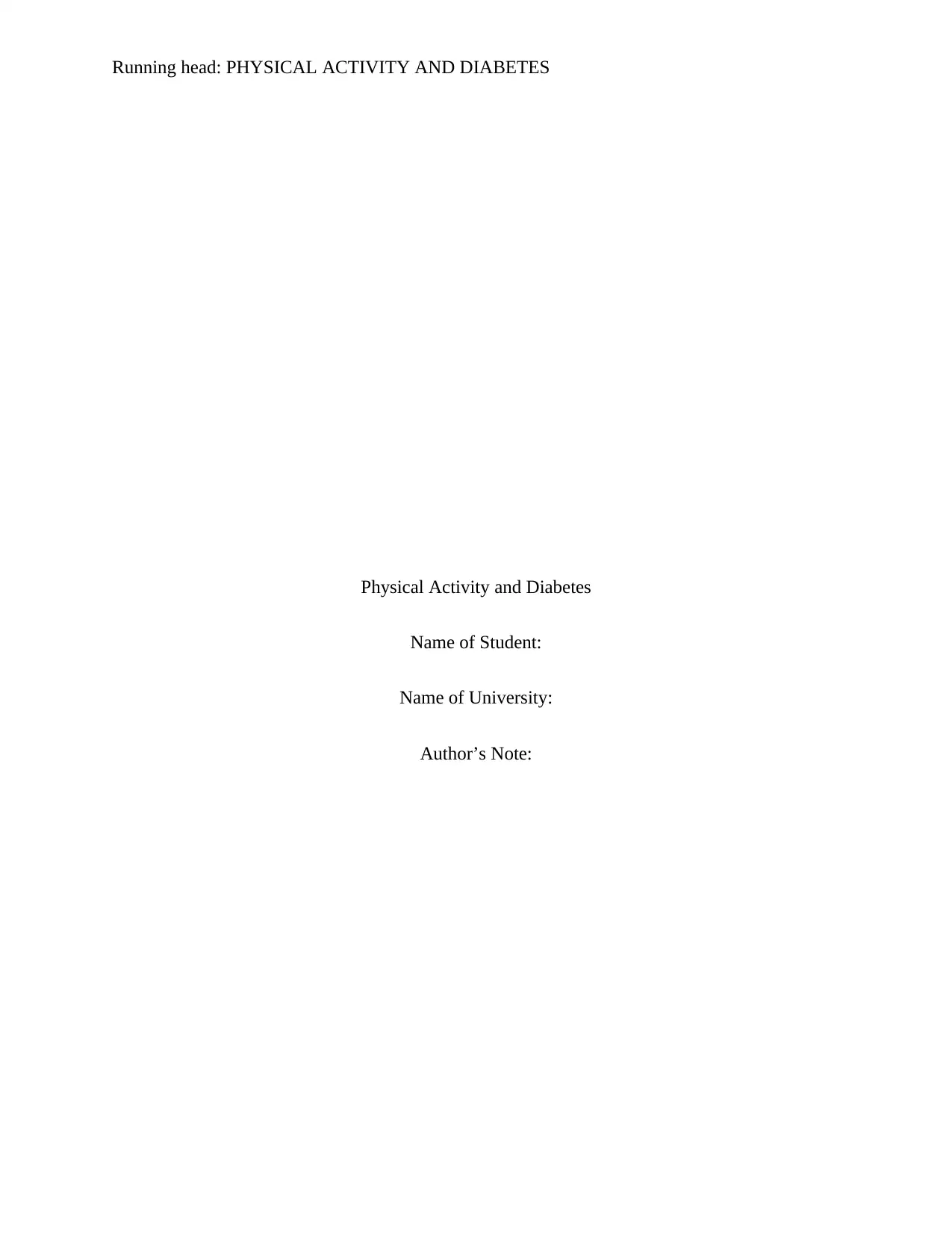
Running head: PHYSICAL ACTIVITY AND DIABETES
Physical Activity and Diabetes
Name of Student:
Name of University:
Author’s Note:
Physical Activity and Diabetes
Name of Student:
Name of University:
Author’s Note:
Secure Best Marks with AI Grader
Need help grading? Try our AI Grader for instant feedback on your assignments.
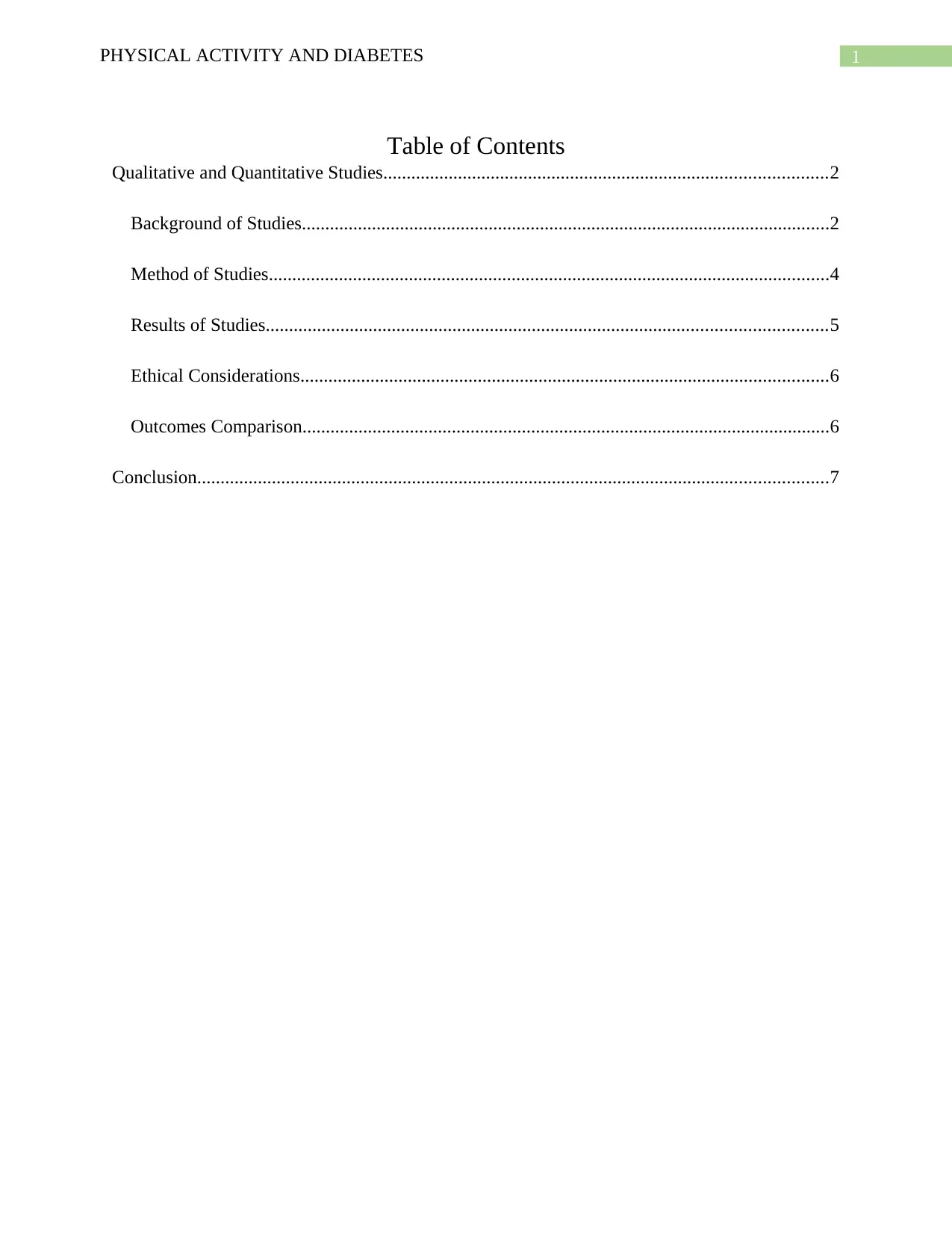
1PHYSICAL ACTIVITY AND DIABETES
Table of Contents
Qualitative and Quantitative Studies...............................................................................................2
Background of Studies.................................................................................................................2
Method of Studies........................................................................................................................4
Results of Studies........................................................................................................................5
Ethical Considerations.................................................................................................................6
Outcomes Comparison.................................................................................................................6
Conclusion.......................................................................................................................................7
Table of Contents
Qualitative and Quantitative Studies...............................................................................................2
Background of Studies.................................................................................................................2
Method of Studies........................................................................................................................4
Results of Studies........................................................................................................................5
Ethical Considerations.................................................................................................................6
Outcomes Comparison.................................................................................................................6
Conclusion.......................................................................................................................................7
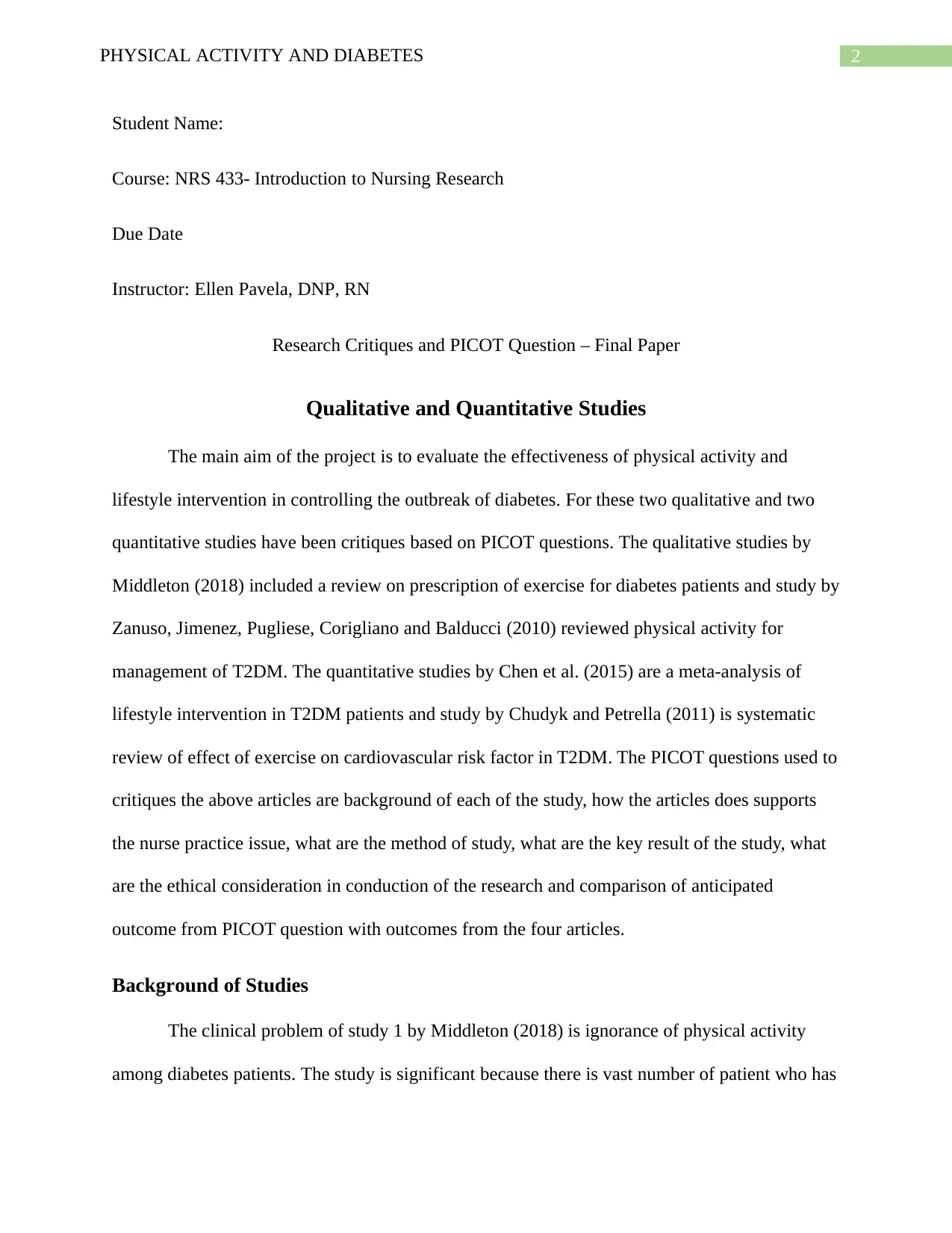
2PHYSICAL ACTIVITY AND DIABETES
Student Name:
Course: NRS 433- Introduction to Nursing Research
Due Date
Instructor: Ellen Pavela, DNP, RN
Research Critiques and PICOT Question – Final Paper
Qualitative and Quantitative Studies
The main aim of the project is to evaluate the effectiveness of physical activity and
lifestyle intervention in controlling the outbreak of diabetes. For these two qualitative and two
quantitative studies have been critiques based on PICOT questions. The qualitative studies by
Middleton (2018) included a review on prescription of exercise for diabetes patients and study by
Zanuso, Jimenez, Pugliese, Corigliano and Balducci (2010) reviewed physical activity for
management of T2DM. The quantitative studies by Chen et al. (2015) are a meta-analysis of
lifestyle intervention in T2DM patients and study by Chudyk and Petrella (2011) is systematic
review of effect of exercise on cardiovascular risk factor in T2DM. The PICOT questions used to
critiques the above articles are background of each of the study, how the articles does supports
the nurse practice issue, what are the method of study, what are the key result of the study, what
are the ethical consideration in conduction of the research and comparison of anticipated
outcome from PICOT question with outcomes from the four articles.
Background of Studies
The clinical problem of study 1 by Middleton (2018) is ignorance of physical activity
among diabetes patients. The study is significant because there is vast number of patient who has
Student Name:
Course: NRS 433- Introduction to Nursing Research
Due Date
Instructor: Ellen Pavela, DNP, RN
Research Critiques and PICOT Question – Final Paper
Qualitative and Quantitative Studies
The main aim of the project is to evaluate the effectiveness of physical activity and
lifestyle intervention in controlling the outbreak of diabetes. For these two qualitative and two
quantitative studies have been critiques based on PICOT questions. The qualitative studies by
Middleton (2018) included a review on prescription of exercise for diabetes patients and study by
Zanuso, Jimenez, Pugliese, Corigliano and Balducci (2010) reviewed physical activity for
management of T2DM. The quantitative studies by Chen et al. (2015) are a meta-analysis of
lifestyle intervention in T2DM patients and study by Chudyk and Petrella (2011) is systematic
review of effect of exercise on cardiovascular risk factor in T2DM. The PICOT questions used to
critiques the above articles are background of each of the study, how the articles does supports
the nurse practice issue, what are the method of study, what are the key result of the study, what
are the ethical consideration in conduction of the research and comparison of anticipated
outcome from PICOT question with outcomes from the four articles.
Background of Studies
The clinical problem of study 1 by Middleton (2018) is ignorance of physical activity
among diabetes patients. The study is significant because there is vast number of patient who has
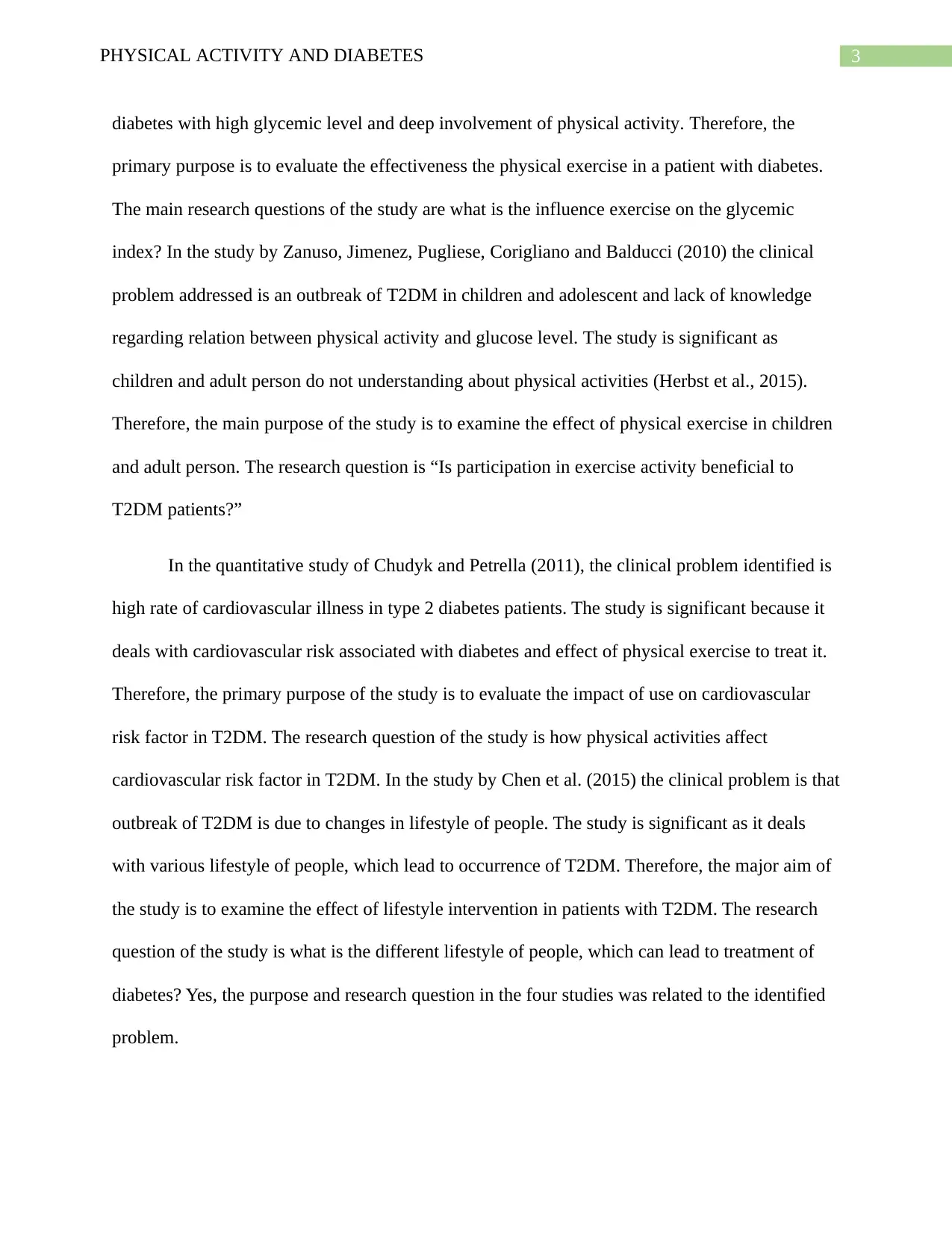
3PHYSICAL ACTIVITY AND DIABETES
diabetes with high glycemic level and deep involvement of physical activity. Therefore, the
primary purpose is to evaluate the effectiveness the physical exercise in a patient with diabetes.
The main research questions of the study are what is the influence exercise on the glycemic
index? In the study by Zanuso, Jimenez, Pugliese, Corigliano and Balducci (2010) the clinical
problem addressed is an outbreak of T2DM in children and adolescent and lack of knowledge
regarding relation between physical activity and glucose level. The study is significant as
children and adult person do not understanding about physical activities (Herbst et al., 2015).
Therefore, the main purpose of the study is to examine the effect of physical exercise in children
and adult person. The research question is “Is participation in exercise activity beneficial to
T2DM patients?”
In the quantitative study of Chudyk and Petrella (2011), the clinical problem identified is
high rate of cardiovascular illness in type 2 diabetes patients. The study is significant because it
deals with cardiovascular risk associated with diabetes and effect of physical exercise to treat it.
Therefore, the primary purpose of the study is to evaluate the impact of use on cardiovascular
risk factor in T2DM. The research question of the study is how physical activities affect
cardiovascular risk factor in T2DM. In the study by Chen et al. (2015) the clinical problem is that
outbreak of T2DM is due to changes in lifestyle of people. The study is significant as it deals
with various lifestyle of people, which lead to occurrence of T2DM. Therefore, the major aim of
the study is to examine the effect of lifestyle intervention in patients with T2DM. The research
question of the study is what is the different lifestyle of people, which can lead to treatment of
diabetes? Yes, the purpose and research question in the four studies was related to the identified
problem.
diabetes with high glycemic level and deep involvement of physical activity. Therefore, the
primary purpose is to evaluate the effectiveness the physical exercise in a patient with diabetes.
The main research questions of the study are what is the influence exercise on the glycemic
index? In the study by Zanuso, Jimenez, Pugliese, Corigliano and Balducci (2010) the clinical
problem addressed is an outbreak of T2DM in children and adolescent and lack of knowledge
regarding relation between physical activity and glucose level. The study is significant as
children and adult person do not understanding about physical activities (Herbst et al., 2015).
Therefore, the main purpose of the study is to examine the effect of physical exercise in children
and adult person. The research question is “Is participation in exercise activity beneficial to
T2DM patients?”
In the quantitative study of Chudyk and Petrella (2011), the clinical problem identified is
high rate of cardiovascular illness in type 2 diabetes patients. The study is significant because it
deals with cardiovascular risk associated with diabetes and effect of physical exercise to treat it.
Therefore, the primary purpose of the study is to evaluate the impact of use on cardiovascular
risk factor in T2DM. The research question of the study is how physical activities affect
cardiovascular risk factor in T2DM. In the study by Chen et al. (2015) the clinical problem is that
outbreak of T2DM is due to changes in lifestyle of people. The study is significant as it deals
with various lifestyle of people, which lead to occurrence of T2DM. Therefore, the major aim of
the study is to examine the effect of lifestyle intervention in patients with T2DM. The research
question of the study is what is the different lifestyle of people, which can lead to treatment of
diabetes? Yes, the purpose and research question in the four studies was related to the identified
problem.
Secure Best Marks with AI Grader
Need help grading? Try our AI Grader for instant feedback on your assignments.
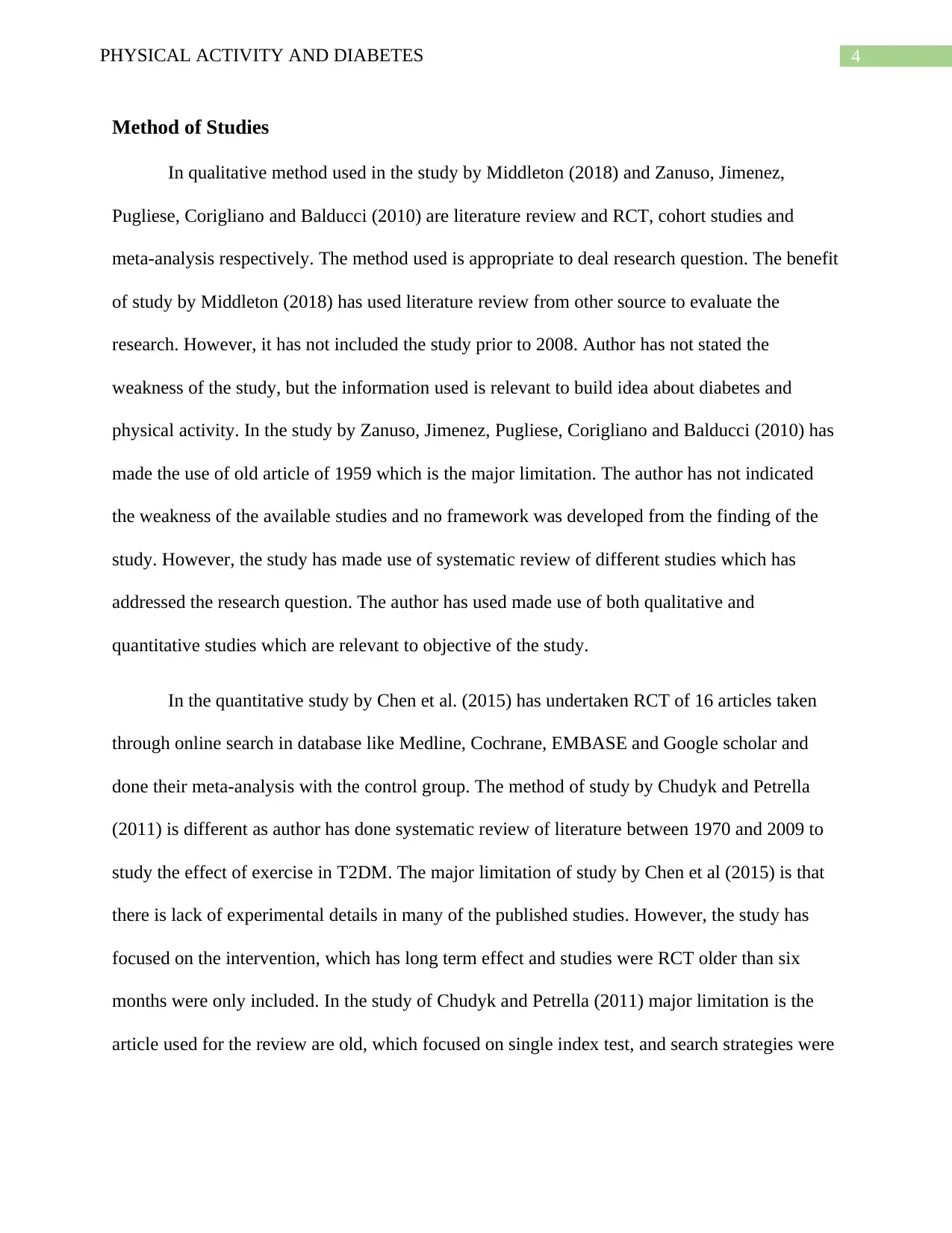
4PHYSICAL ACTIVITY AND DIABETES
Method of Studies
In qualitative method used in the study by Middleton (2018) and Zanuso, Jimenez,
Pugliese, Corigliano and Balducci (2010) are literature review and RCT, cohort studies and
meta-analysis respectively. The method used is appropriate to deal research question. The benefit
of study by Middleton (2018) has used literature review from other source to evaluate the
research. However, it has not included the study prior to 2008. Author has not stated the
weakness of the study, but the information used is relevant to build idea about diabetes and
physical activity. In the study by Zanuso, Jimenez, Pugliese, Corigliano and Balducci (2010) has
made the use of old article of 1959 which is the major limitation. The author has not indicated
the weakness of the available studies and no framework was developed from the finding of the
study. However, the study has made use of systematic review of different studies which has
addressed the research question. The author has used made use of both qualitative and
quantitative studies which are relevant to objective of the study.
In the quantitative study by Chen et al. (2015) has undertaken RCT of 16 articles taken
through online search in database like Medline, Cochrane, EMBASE and Google scholar and
done their meta-analysis with the control group. The method of study by Chudyk and Petrella
(2011) is different as author has done systematic review of literature between 1970 and 2009 to
study the effect of exercise in T2DM. The major limitation of study by Chen et al (2015) is that
there is lack of experimental details in many of the published studies. However, the study has
focused on the intervention, which has long term effect and studies were RCT older than six
months were only included. In the study of Chudyk and Petrella (2011) major limitation is the
article used for the review are old, which focused on single index test, and search strategies were
Method of Studies
In qualitative method used in the study by Middleton (2018) and Zanuso, Jimenez,
Pugliese, Corigliano and Balducci (2010) are literature review and RCT, cohort studies and
meta-analysis respectively. The method used is appropriate to deal research question. The benefit
of study by Middleton (2018) has used literature review from other source to evaluate the
research. However, it has not included the study prior to 2008. Author has not stated the
weakness of the study, but the information used is relevant to build idea about diabetes and
physical activity. In the study by Zanuso, Jimenez, Pugliese, Corigliano and Balducci (2010) has
made the use of old article of 1959 which is the major limitation. The author has not indicated
the weakness of the available studies and no framework was developed from the finding of the
study. However, the study has made use of systematic review of different studies which has
addressed the research question. The author has used made use of both qualitative and
quantitative studies which are relevant to objective of the study.
In the quantitative study by Chen et al. (2015) has undertaken RCT of 16 articles taken
through online search in database like Medline, Cochrane, EMBASE and Google scholar and
done their meta-analysis with the control group. The method of study by Chudyk and Petrella
(2011) is different as author has done systematic review of literature between 1970 and 2009 to
study the effect of exercise in T2DM. The major limitation of study by Chen et al (2015) is that
there is lack of experimental details in many of the published studies. However, the study has
focused on the intervention, which has long term effect and studies were RCT older than six
months were only included. In the study of Chudyk and Petrella (2011) major limitation is the
article used for the review are old, which focused on single index test, and search strategies were
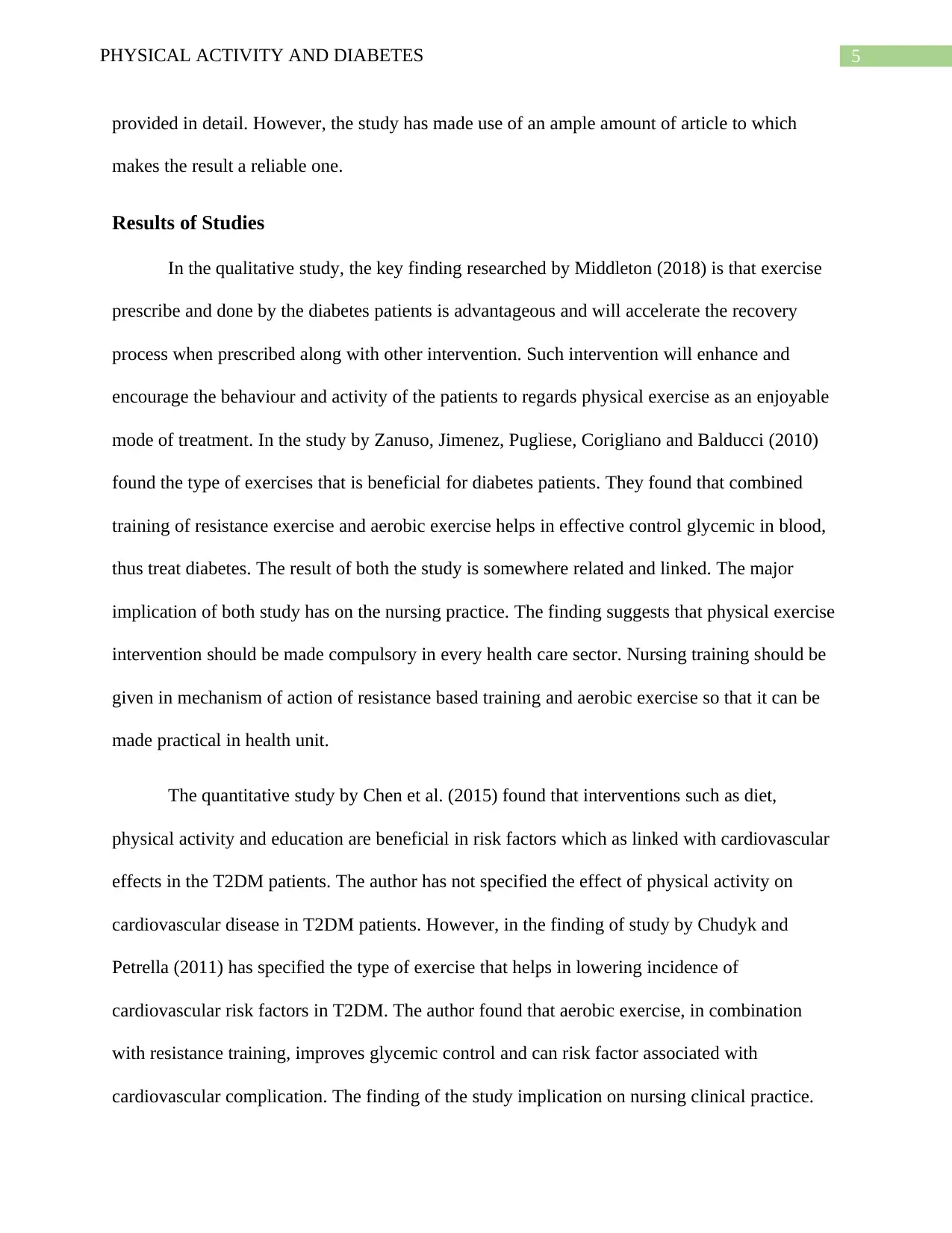
5PHYSICAL ACTIVITY AND DIABETES
provided in detail. However, the study has made use of an ample amount of article to which
makes the result a reliable one.
Results of Studies
In the qualitative study, the key finding researched by Middleton (2018) is that exercise
prescribe and done by the diabetes patients is advantageous and will accelerate the recovery
process when prescribed along with other intervention. Such intervention will enhance and
encourage the behaviour and activity of the patients to regards physical exercise as an enjoyable
mode of treatment. In the study by Zanuso, Jimenez, Pugliese, Corigliano and Balducci (2010)
found the type of exercises that is beneficial for diabetes patients. They found that combined
training of resistance exercise and aerobic exercise helps in effective control glycemic in blood,
thus treat diabetes. The result of both the study is somewhere related and linked. The major
implication of both study has on the nursing practice. The finding suggests that physical exercise
intervention should be made compulsory in every health care sector. Nursing training should be
given in mechanism of action of resistance based training and aerobic exercise so that it can be
made practical in health unit.
The quantitative study by Chen et al. (2015) found that interventions such as diet,
physical activity and education are beneficial in risk factors which as linked with cardiovascular
effects in the T2DM patients. The author has not specified the effect of physical activity on
cardiovascular disease in T2DM patients. However, in the finding of study by Chudyk and
Petrella (2011) has specified the type of exercise that helps in lowering incidence of
cardiovascular risk factors in T2DM. The author found that aerobic exercise, in combination
with resistance training, improves glycemic control and can risk factor associated with
cardiovascular complication. The finding of the study implication on nursing clinical practice.
provided in detail. However, the study has made use of an ample amount of article to which
makes the result a reliable one.
Results of Studies
In the qualitative study, the key finding researched by Middleton (2018) is that exercise
prescribe and done by the diabetes patients is advantageous and will accelerate the recovery
process when prescribed along with other intervention. Such intervention will enhance and
encourage the behaviour and activity of the patients to regards physical exercise as an enjoyable
mode of treatment. In the study by Zanuso, Jimenez, Pugliese, Corigliano and Balducci (2010)
found the type of exercises that is beneficial for diabetes patients. They found that combined
training of resistance exercise and aerobic exercise helps in effective control glycemic in blood,
thus treat diabetes. The result of both the study is somewhere related and linked. The major
implication of both study has on the nursing practice. The finding suggests that physical exercise
intervention should be made compulsory in every health care sector. Nursing training should be
given in mechanism of action of resistance based training and aerobic exercise so that it can be
made practical in health unit.
The quantitative study by Chen et al. (2015) found that interventions such as diet,
physical activity and education are beneficial in risk factors which as linked with cardiovascular
effects in the T2DM patients. The author has not specified the effect of physical activity on
cardiovascular disease in T2DM patients. However, in the finding of study by Chudyk and
Petrella (2011) has specified the type of exercise that helps in lowering incidence of
cardiovascular risk factors in T2DM. The author found that aerobic exercise, in combination
with resistance training, improves glycemic control and can risk factor associated with
cardiovascular complication. The finding of the study implication on nursing clinical practice.
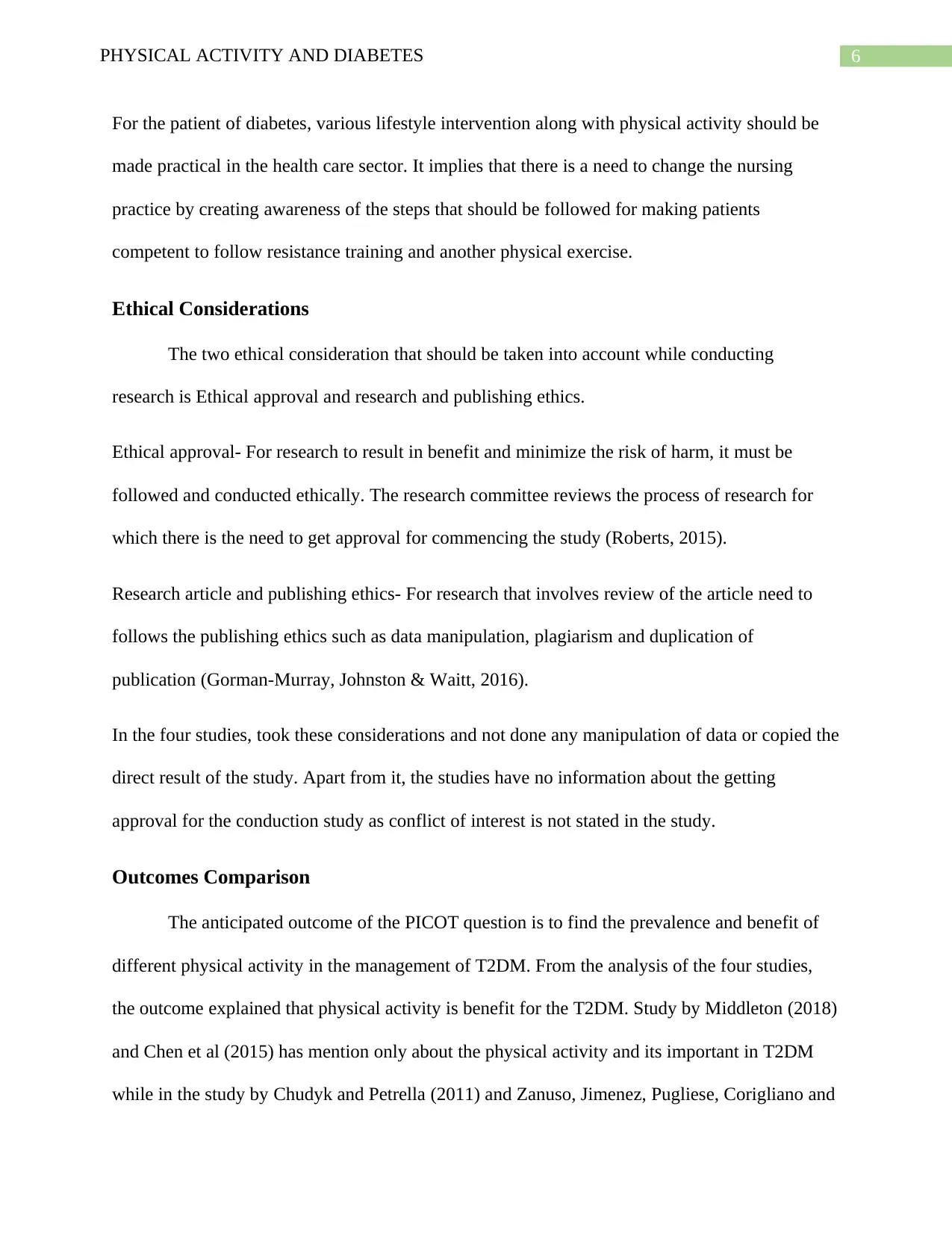
6PHYSICAL ACTIVITY AND DIABETES
For the patient of diabetes, various lifestyle intervention along with physical activity should be
made practical in the health care sector. It implies that there is a need to change the nursing
practice by creating awareness of the steps that should be followed for making patients
competent to follow resistance training and another physical exercise.
Ethical Considerations
The two ethical consideration that should be taken into account while conducting
research is Ethical approval and research and publishing ethics.
Ethical approval- For research to result in benefit and minimize the risk of harm, it must be
followed and conducted ethically. The research committee reviews the process of research for
which there is the need to get approval for commencing the study (Roberts, 2015).
Research article and publishing ethics- For research that involves review of the article need to
follows the publishing ethics such as data manipulation, plagiarism and duplication of
publication (Gorman-Murray, Johnston & Waitt, 2016).
In the four studies, took these considerations and not done any manipulation of data or copied the
direct result of the study. Apart from it, the studies have no information about the getting
approval for the conduction study as conflict of interest is not stated in the study.
Outcomes Comparison
The anticipated outcome of the PICOT question is to find the prevalence and benefit of
different physical activity in the management of T2DM. From the analysis of the four studies,
the outcome explained that physical activity is benefit for the T2DM. Study by Middleton (2018)
and Chen et al (2015) has mention only about the physical activity and its important in T2DM
while in the study by Chudyk and Petrella (2011) and Zanuso, Jimenez, Pugliese, Corigliano and
For the patient of diabetes, various lifestyle intervention along with physical activity should be
made practical in the health care sector. It implies that there is a need to change the nursing
practice by creating awareness of the steps that should be followed for making patients
competent to follow resistance training and another physical exercise.
Ethical Considerations
The two ethical consideration that should be taken into account while conducting
research is Ethical approval and research and publishing ethics.
Ethical approval- For research to result in benefit and minimize the risk of harm, it must be
followed and conducted ethically. The research committee reviews the process of research for
which there is the need to get approval for commencing the study (Roberts, 2015).
Research article and publishing ethics- For research that involves review of the article need to
follows the publishing ethics such as data manipulation, plagiarism and duplication of
publication (Gorman-Murray, Johnston & Waitt, 2016).
In the four studies, took these considerations and not done any manipulation of data or copied the
direct result of the study. Apart from it, the studies have no information about the getting
approval for the conduction study as conflict of interest is not stated in the study.
Outcomes Comparison
The anticipated outcome of the PICOT question is to find the prevalence and benefit of
different physical activity in the management of T2DM. From the analysis of the four studies,
the outcome explained that physical activity is benefit for the T2DM. Study by Middleton (2018)
and Chen et al (2015) has mention only about the physical activity and its important in T2DM
while in the study by Chudyk and Petrella (2011) and Zanuso, Jimenez, Pugliese, Corigliano and
Paraphrase This Document
Need a fresh take? Get an instant paraphrase of this document with our AI Paraphraser
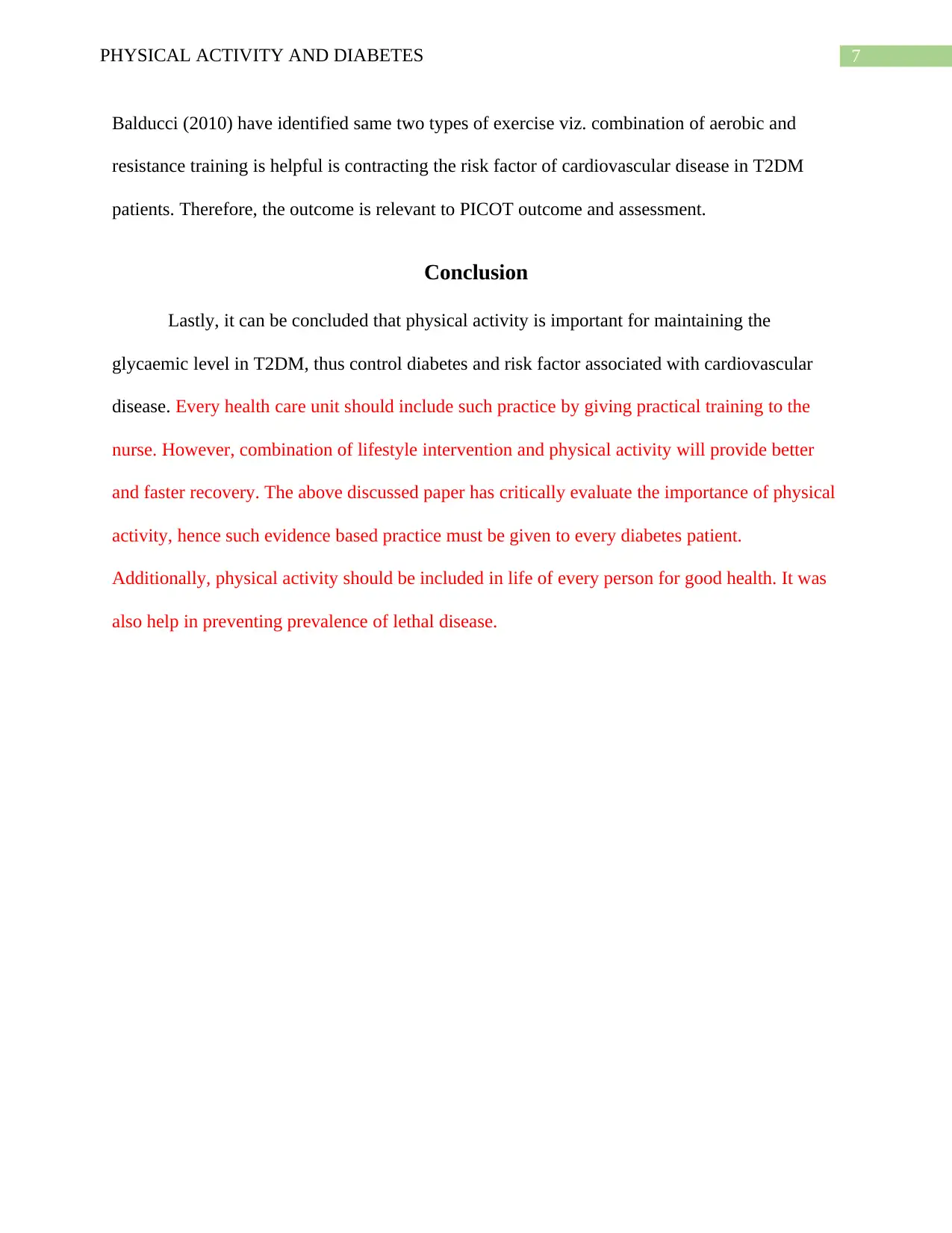
7PHYSICAL ACTIVITY AND DIABETES
Balducci (2010) have identified same two types of exercise viz. combination of aerobic and
resistance training is helpful is contracting the risk factor of cardiovascular disease in T2DM
patients. Therefore, the outcome is relevant to PICOT outcome and assessment.
Conclusion
Lastly, it can be concluded that physical activity is important for maintaining the
glycaemic level in T2DM, thus control diabetes and risk factor associated with cardiovascular
disease. Every health care unit should include such practice by giving practical training to the
nurse. However, combination of lifestyle intervention and physical activity will provide better
and faster recovery. The above discussed paper has critically evaluate the importance of physical
activity, hence such evidence based practice must be given to every diabetes patient.
Additionally, physical activity should be included in life of every person for good health. It was
also help in preventing prevalence of lethal disease.
Balducci (2010) have identified same two types of exercise viz. combination of aerobic and
resistance training is helpful is contracting the risk factor of cardiovascular disease in T2DM
patients. Therefore, the outcome is relevant to PICOT outcome and assessment.
Conclusion
Lastly, it can be concluded that physical activity is important for maintaining the
glycaemic level in T2DM, thus control diabetes and risk factor associated with cardiovascular
disease. Every health care unit should include such practice by giving practical training to the
nurse. However, combination of lifestyle intervention and physical activity will provide better
and faster recovery. The above discussed paper has critically evaluate the importance of physical
activity, hence such evidence based practice must be given to every diabetes patient.
Additionally, physical activity should be included in life of every person for good health. It was
also help in preventing prevalence of lethal disease.
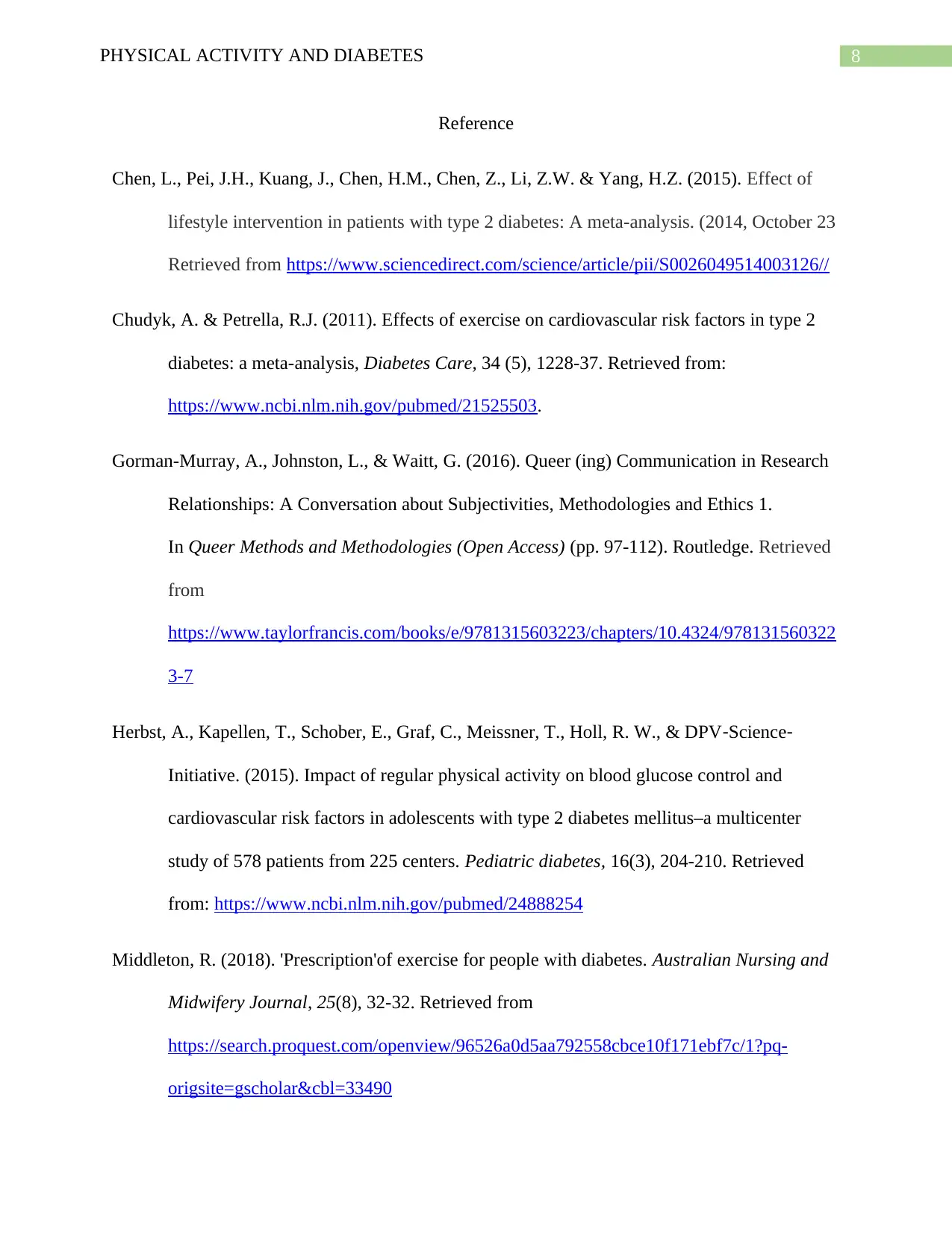
8PHYSICAL ACTIVITY AND DIABETES
Reference
Chen, L., Pei, J.H., Kuang, J., Chen, H.M., Chen, Z., Li, Z.W. & Yang, H.Z. (2015). Effect of
lifestyle intervention in patients with type 2 diabetes: A meta-analysis. (2014, October 23
Retrieved from https://www.sciencedirect.com/science/article/pii/S0026049514003126//
Chudyk, A. & Petrella, R.J. (2011). Effects of exercise on cardiovascular risk factors in type 2
diabetes: a meta-analysis, Diabetes Care, 34 (5), 1228-37. Retrieved from:
https://www.ncbi.nlm.nih.gov/pubmed/21525503.
Gorman-Murray, A., Johnston, L., & Waitt, G. (2016). Queer (ing) Communication in Research
Relationships: A Conversation about Subjectivities, Methodologies and Ethics 1.
In Queer Methods and Methodologies (Open Access) (pp. 97-112). Routledge. Retrieved
from
https://www.taylorfrancis.com/books/e/9781315603223/chapters/10.4324/978131560322
3-7
Herbst, A., Kapellen, T., Schober, E., Graf, C., Meissner, T., Holl, R. W., & DPV‐Science‐
Initiative. (2015). Impact of regular physical activity on blood glucose control and
cardiovascular risk factors in adolescents with type 2 diabetes mellitus–a multicenter
study of 578 patients from 225 centers. Pediatric diabetes, 16(3), 204-210. Retrieved
from: https://www.ncbi.nlm.nih.gov/pubmed/24888254
Middleton, R. (2018). 'Prescription'of exercise for people with diabetes. Australian Nursing and
Midwifery Journal, 25(8), 32-32. Retrieved from
https://search.proquest.com/openview/96526a0d5aa792558cbce10f171ebf7c/1?pq-
origsite=gscholar&cbl=33490
Reference
Chen, L., Pei, J.H., Kuang, J., Chen, H.M., Chen, Z., Li, Z.W. & Yang, H.Z. (2015). Effect of
lifestyle intervention in patients with type 2 diabetes: A meta-analysis. (2014, October 23
Retrieved from https://www.sciencedirect.com/science/article/pii/S0026049514003126//
Chudyk, A. & Petrella, R.J. (2011). Effects of exercise on cardiovascular risk factors in type 2
diabetes: a meta-analysis, Diabetes Care, 34 (5), 1228-37. Retrieved from:
https://www.ncbi.nlm.nih.gov/pubmed/21525503.
Gorman-Murray, A., Johnston, L., & Waitt, G. (2016). Queer (ing) Communication in Research
Relationships: A Conversation about Subjectivities, Methodologies and Ethics 1.
In Queer Methods and Methodologies (Open Access) (pp. 97-112). Routledge. Retrieved
from
https://www.taylorfrancis.com/books/e/9781315603223/chapters/10.4324/978131560322
3-7
Herbst, A., Kapellen, T., Schober, E., Graf, C., Meissner, T., Holl, R. W., & DPV‐Science‐
Initiative. (2015). Impact of regular physical activity on blood glucose control and
cardiovascular risk factors in adolescents with type 2 diabetes mellitus–a multicenter
study of 578 patients from 225 centers. Pediatric diabetes, 16(3), 204-210. Retrieved
from: https://www.ncbi.nlm.nih.gov/pubmed/24888254
Middleton, R. (2018). 'Prescription'of exercise for people with diabetes. Australian Nursing and
Midwifery Journal, 25(8), 32-32. Retrieved from
https://search.proquest.com/openview/96526a0d5aa792558cbce10f171ebf7c/1?pq-
origsite=gscholar&cbl=33490
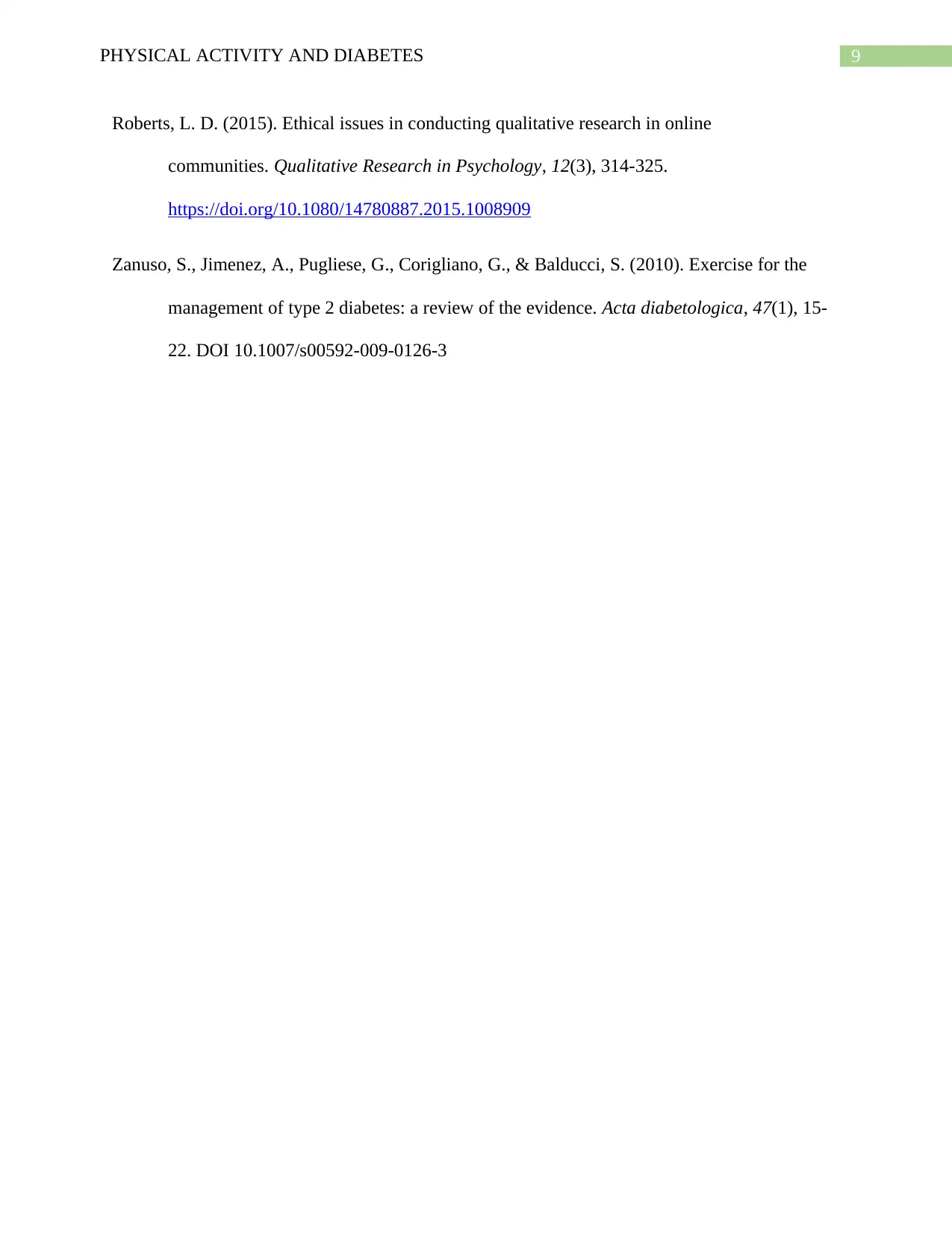
9PHYSICAL ACTIVITY AND DIABETES
Roberts, L. D. (2015). Ethical issues in conducting qualitative research in online
communities. Qualitative Research in Psychology, 12(3), 314-325.
https://doi.org/10.1080/14780887.2015.1008909
Zanuso, S., Jimenez, A., Pugliese, G., Corigliano, G., & Balducci, S. (2010). Exercise for the
management of type 2 diabetes: a review of the evidence. Acta diabetologica, 47(1), 15-
22. DOI 10.1007/s00592-009-0126-3
Roberts, L. D. (2015). Ethical issues in conducting qualitative research in online
communities. Qualitative Research in Psychology, 12(3), 314-325.
https://doi.org/10.1080/14780887.2015.1008909
Zanuso, S., Jimenez, A., Pugliese, G., Corigliano, G., & Balducci, S. (2010). Exercise for the
management of type 2 diabetes: a review of the evidence. Acta diabetologica, 47(1), 15-
22. DOI 10.1007/s00592-009-0126-3
1 out of 10
Related Documents
Your All-in-One AI-Powered Toolkit for Academic Success.
+13062052269
info@desklib.com
Available 24*7 on WhatsApp / Email
![[object Object]](/_next/static/media/star-bottom.7253800d.svg)
Unlock your academic potential
© 2024 | Zucol Services PVT LTD | All rights reserved.


